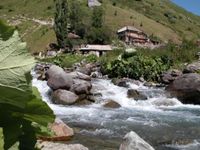Commentary of South Ossetia Foreign Minister D.G. Sanakoyev
The media continues to discuss the article from the newspaper "Izvestia" published on 14 August 2012. It reported that allegedly to the order of the President of the Republic of South Ossetia L.Kh. Tibilov "several Georgian villages located to the north of the capital of the Republic will be taken down” in South Ossetia. Current and former Georgian politicians are concerned about this article as well as some representatives of international organizations, including the OSCE High Commissioner on National Minorities, Mr. Vollebaek.
This manifestly provocative article caused, to put it mildly, surprise in South Ossetia, since, first of all, South Ossetian President Leonid Tibilov did not issue any decree or order for the demolition of villages to the north of Tskhinval, secondly, there have never been any " Georgian enclaves" in the Republic of South Ossetia. These were the villages with a mixed Georgian-Ossetian population where in 1989-1992 the Georgian nationalists carried out ethnic cleansing. As a result, the Ossetian population which formed from 30 to 50 percent of the residents was banished, and the houses were burnt down or looted. When Ossetians were expelled from these communities located in the gorge of the river Great Liakhva, and during the entire period of the Georgian-Ossetian conflict, the most atrocious crimes against the Ossetian people were committed in these villages turned into an outpost against South Ossetia, it bothered little the representatives of OSCE and Georgian human rights activists.
The comment of ex-President Shevardnadze: ‘if Tibilov has devised such barbarism, it would be a tragedy’, can only be regarded as cynical. Underlining once more that the President Tibilov has not devised any "barbarism", we wonder how one can qualify the words of Mr. Shevardnadze, when as a head of Georgia in May 13, 1992 he visited the family of a little girl killed with Georgian shells the night before in the bleeding Tskhinval, and the next day at a meeting in the town of Gori he criticized his subordinates for the fact that forces attacking Tskhinval did not have enough ammunition. In addition, during his ruling Georgian militants committed one of the worst atrocities against the Ossetian people and humanity - in May 20, 1992 on the Zar road they shot peaceful Ossetian refugees - women, children, and the elderly, and nobody has been in charge of this up to now.
As for the villages north of Tskhinval because of which the fuss has been kicked up, these villages as well as other villages around Tskhinval were in the combat zone in August 2008 and they were completely destroyed and burnt. All responsibility for this lies with Saakashvili and those who have committed aggression in August 2008. Competent independent international experts recognized Georgia as an aggressor, and Mr. Shevardnadze repeatedly called the instigator of the war the current Georgian leadership. So the media campaign to "protect" these villages is no more than another propaganda campaign.
The alleged statements that South Ossetian authorities are "demolishing churches" and other monuments in above mentioned and nearby villages are completely baseless. All historical and cultural monuments on the territory of South Ossetia are the property of its people and they are under the protection of the State. When co-chairs of Geneva discussions on security in Transcaucasia visited the territories to the north of Tskhinval they made sure that the churches are in good state.
The responsibility for the fate of the Georgian people living in those villages before the August aggression in 2008 and leaving them for Georgia before the war in August 2008 on orders from Tbilisi fully lies with the Georgian government which was planning to turn South Ossetia into ‘open field.’ South Ossetian authorities do not ethnically distinguish the citizens and repeatedly expressed willingness to resolve all issues, including refugee ones in accordance with international law and existing realities.
And the reality is that the Republic of South Ossetia is a recognized sovereign state seeking to heal the wounds received from Georgia's aggression as soon as possible, and to rehabilitate the affected areas in the interests of the people.
Tskhinval,
September 5, 2012

